A
BYTE OUT OF HISTORY
Escape
from Alcatraz
06/08/07
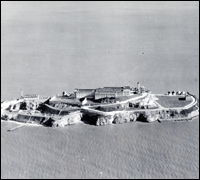 |
Aerial
view of Alcatraz Island,
January 1932. |
In
its heyday, it was the ultimate maximum security
prison.
Located on a lonely island in the middle
of San Francisco Bay, Alcatraz—aka “The
Rock”—had held captives since
the Civil War. But it was in 1934, the highpoint
of a major war on crime, that Alcatraz was
re-fortified into the world’s most
secure prison. Its eventual inmates included
dangerous public enemies like Al
Capone,
criminals who had a history of escapes, and
the occasional
odd character like the infamous “Birdman
of Alcatraz.”
In the 1930s, Alcatraz was already a forbidding
place, surrounded by the cold, rough waters
of the Pacific. The redesign included tougher
iron bars, a series of strategically positioned
guard towers, and strict rules, including
a dozen checks a day of the prisoners. Escape
seemed near impossible.
Despite the odds, from 1934 until the prison
was closed in 1963, 36 men tried 14 separate
escapes. Nearly all were caught or didn’t
survive the attempt.
The fate of three particular inmates, however,
remains a mystery to this day. Here is their
story, which played out 45 years ago this
month.
* * * *
 |
Side
view of model head found in Frank Morris’s
cell. |
Missing. On June 12, 1962,
the routine early morning bed check turned
out to be
anything
but. Three convicts were not in their cells:
John Anglin, his brother Clarence, and
Frank Morris. In their beds were cleverly
built
dummy heads made of plaster, flesh-tone
paint, and real human hair that apparently
fooled
the night guards. The prison went into
lock down, and an intensive search began.
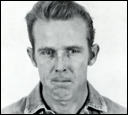 |
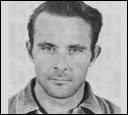 |
 |
John Anglin |
Clarence Anglin |
Frank Morris |
 |
Homemade
paddle recovered at prison.
A similar
one was recovered on
Angel Island.
|
Gathering the Clues. We were notified immediately
and asked to help. Our office in San Francisco
set leads for offices nationwide to check
for any records on the missing prisoners
and on their previous escape attempts (all
three had made them). We also interviewed
relatives of the men and compiled all their
identification records and asked boat operators
in the Bay to be on the lookout for debris.
Within two days, a packet of letters sealed
in rubber and related to the men was recovered.
Later, some paddle-like pieces of wood and
bits of rubber inner tube were found in the
water. A homemade life-vest was also discovered
washed up on Cronkhite Beach, but extensive
searches did not turn up any other items
in the area.
Piecing together the plan. As the days went
by, the FBI, the Coast Guard, Bureau of Prison
authorities, and others began to find more
evidence and piece together the ingenious
escape plan. We were aided by a fourth plotter
who didn’t make it out of his cell
in time and began providing us with information.
Here’s what we learned.
-
Using crude tools—including
a homemade drill made from the motor
of a broken vacuum
cleaner—the plotters each loosened
the air vents at the back of their
cells by painstakingly drilling closely
spaced
holes around the cover so the entire
section of the wall could be removed.
Once through,
they hid the holes with whatever they
could—a
suitcase, a piece of cardboard, etc.
 |
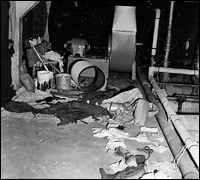 |
View
of ventilation grate through which prisoners
gained access to utility corridor behind
Cell Block “B”. |
Portion
of concealed area on top of
Cell Block “B” Prisoners
constructed
tools for their escape here. |
Behind the cells was a common, unguarded
utility corridor. They made their
way down this corridor and climbed to the
roof of
their cell block inside the building,
where they set up a secret workshop.
There, taking
turns keeping watch for the guards
in the evening before the last count
(see
the crude “periscope” they
constructed for the lookouts), they
used a variety of stolen and donated
materials
to build and hide what they needed
to escape. More than 50 raincoats
that they stole or
gathered were turned into makeshift
life preservers and a 6x14 foot rubber
raft, the
seams carefully stitched together
and “vulcanized” by
the hot steam pipes in the prison
(the idea came from magazines that
were
found in the
prisoners’ cells). They also
built wooden paddles and converted
a musical
instrument into a tool to inflate
the raft.
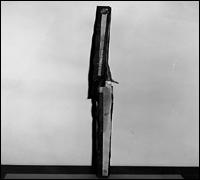 |
 |
Periscope
made to spy on guards while prisoners
worked. |
Inside view of discarded raft found
at
prison.
|
At the same time, they
were looking for a way out of
the building. The
ceiling was
a good 30 feet high, but using
a network of pipes they climbed up
and eventually
pried open the ventilator at
the top of the shaft.
They kept it in place temporarily
by fashioning a fake bolt out
of soap.
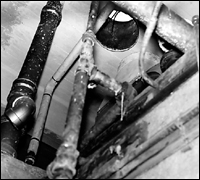 |
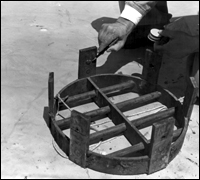 |
View
from catwalk above Cell Block B showing
route prisoners
took to access the roof of Cell House. |
Ventilator
cover on roof. Agent points to “bolt” made
of soap that disguised that the real
bolt had
been removed. |
The escape. On the evening of June 11, they
were ready to go. The prison informant, though,
did not have his ventilator grill completely
removed and was left behind. The three others
got into the corridor, gathered their gear,
climbed up and out through the ventilator,
and got on to the prison roof. Then, they
shimmied down the bakery smoke stack at the
rear of the cell house, climbed over the
fence, and snuck to the northeast shore of
the island and launched their raft.
 |
 |
45’ high
bake oven chimney stack used by prisoners
to descend from roof of Cell House
to lower level. |
Lower
right corner of picture shows the area
from which
the prisoners likely entered the water
to escape. |
What happened next remains a mystery. Did
they make it across the Bay, get to Angel
Island, and then cross Raccoon Straight into
Marin County as planned? Or did the wind
and waves get the better of them?
Solving the mystery. Plenty of people have
gone to great lengths to prove that the men
COULD have survived, but the question remains:
did they? Our investigation at the time concluded
otherwise, for the following reasons.
-
Crossing the Bay. Yes,
youngsters have made the more than mile-long
swim from Alcatraz
to Angel Island. But with the strong
currents and frigid Bay water, the odds
were clearly
against these men.
-
Three if by land. The plan, according to our prison informant,
was to steal clothes
and a car once on land. But we never
uncovered
any thefts like this despite the
high-profile nature of the case.
-
Family
ties. If the escapees had help, we couldn’t
substantiate it. The families appeared
unlikely
to even have the financial
means to provide any real support.
-
Missing in action. For the 17 years
we worked on the case, no
credible
evidence
emerged to suggest the men
were still alive, either in the U.S.
or overseas.
The mystery continues… We officially
closed our case on December 31, 1979, and
turned over responsibility to the U.S. Marshals
Service, which continues to investigate in
the unlikely event the trio is still alive.
If you have ANY leads or information to share,
please call Deputy U.S. Marshall Michael
Dyke of the Northern District of California
at (415) 436-7677. It’s one mystery
we’d all like to solve!
Resources:
-- FBI History
website
-- More
Byte Out of History stories
|
|
|


